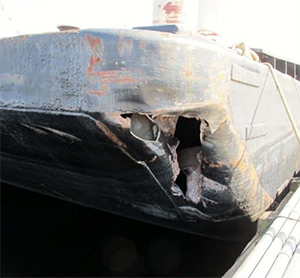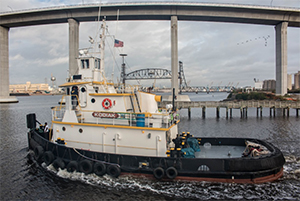Failure to account for bank effect likely caused a bridge strike last year in the Intracoastal Waterway off Chesapeake, Va., according to the National Transportation Safety Board, which also cited the mate’s lack of experience navigating through tight waterways.
Authorities also found evidence the mate falsified sea time needed to upgrade his license, the NTSB said in its report. The mate surrendered his license in May 2016 rather than face a hearing into the incident and licensing inconsistencies.
The accident happened on March 1, 2016, as the 800-hp Kodiak pushed the empty barge SJ-199 north in the North Landing River. The mate was at the controls at the time. The barge’s port corner rake struck the fender system protecting the North Landing Bridge at about 0322. Damage to the structure and barge was estimated at $275,000.
“With little or no experience navigating on narrow waterways or pushing a barge, the mate lost control of his vessel as he steered the tow through the bends,” the NTSB report said. “He probably was unaware that he needed to compensate for sliding across the river as he made his turns as well as compensating for the bank effect.”
Kodiak departed Edenton, N.C., for Baltimore the day before the incident with four crew. The route included several narrow inland waterways. The mate relieved the captain at midnight on March 1, marking his time in charge of a tugboat watch. The voyage also was his first through the ICW.
Roughly 1.6 miles from the bridge, the North Landing River bends 72 degrees to the west, then straightens before bending 15 degrees to the north. As the vessels approached the span, the tow hit a mooring dolphin along the NuStar Energy terminal dock.
 |
|
The impact with the North Landing Bridge breached barge SJ-199’s portside rake. |
|
Courtesy NTSB |
From that point, the vessels had 750 yards to line up for the opened swing bridge, and the mate placed the tug’s engines in neutral to reduce speed. The vessels were traveling at about 1.5 knots when the barge hit the left bridge fender, the report said. The impact caused a breach on the port-side rake above the waterline.
The impact woke the captain, who returned to the wheelhouse. With a lookout stationed at the barge’s bow, the mate steered the tow through the bridge.
The mate at the controls of Kodiak earned his deck officer-mate credential in March 2015 for towing vessels in near-coastal waters. However, the Coast Guard found evidence after the accident that he had exaggerated his sea time.
“He had met his 18-month sea service time on board towing vessels to qualify as an apprentice mate,” the report said. “However, as an apprentice mate he falsified 56 12-hour days (84 eight-hour days) of the required 360 eight-hour days the Coast Guard required to upgrade his license.”
Intracoastal Marine, which operates Kodiak, hired the mate two months before the accident. Federal investigators said the company was unaware the mate had not been serving on board vessels since October 2014. When applying for the job, the mate reportedly said he served in that position through April 2015. Intracoastal declined to comment.
Although the mate’s Towing Officers’ Assessment Record (TOAR): Near Coastal/Oceans submission met existing standards at the time, it did not gauge his ability to handle tows in tight waterways, the report said. Following the accident, the Coast Guard revised those credentialing guidelines to include steering through a bridge.
The NTSB did not identify the mate, and the Coast Guard did not respond to a Freedom of Information Act request with that information by press time.

